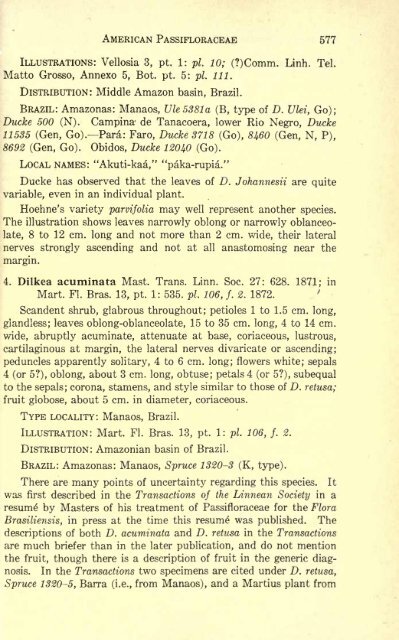downloads/Killip 2.pdf - Passion Flowers
downloads/Killip 2.pdf - Passion Flowers
downloads/Killip 2.pdf - Passion Flowers
Create successful ePaper yourself
Turn your PDF publications into a flip-book with our unique Google optimized e-Paper software.
AMERICAN PASSIFLORACEAE 577<br />
ILLUSTRATIONS: Vellosia 3, pt. 1: pi. 10; (?)Comm. Linh. Tel.<br />
Matto Grosso, Annexe 5, Bot. pt. 5: pi. 111.<br />
DISTRIBUTION: Middle Amazon basin, Brazil.<br />
BRAZIL: Amazonas: Manaos, Ule5381a (B, type of D. Ulei, Go);<br />
Ducke 500 (N). Campina- de Tanacoera, lower Rio Negro, Ducke<br />
11535 (Gen, Go). Para: Faro, Ducke 3718 (Go), 8460 (Gen, N, P),<br />
8692 (Gen, Go). Obidos, Ducke 12040 (Go).<br />
LOCAL NAMES: "Akuti-kaa," "paka-rupia."<br />
Ducke has observed that the leaves of D. Johannesii are quite<br />
variable, even in an individual plant.<br />
Hoehne's variety parvifolia may well represent another species.<br />
The illustration shows leaves narrowly oblong or narrowly oblanceolate,<br />
8 to 12 cm. long and not more than 2 cm. wide, their lateral<br />
nerves strongly ascending and not at all anastomosing near the<br />
margin.<br />
4. Dilkea acuminata Mast. Trans. Linn. Soc. 27: 628. 1871; in<br />
Mart. Fl. Bras. 13, pt. 1: 535. pi. 106, f. 2. 1872.<br />
Scandent shrub, glabrous throughout; petioles 1 to 1.5 cm. long,<br />
glandless; leaves oblong-oblanceolate, 15 to 35 cm. long, 4 to 14 cm.<br />
wide, abruptly acuminate, attenuate at base, coriaceous, lustrous,<br />
cartilaginous at margin, the lateral nerves divaricate or ascending;<br />
peduncles apparently solitary, 4 to 6 cm. long; flowers white; sepals<br />
4 (or 5?), oblong, about 3 cm. long, obtuse; petals 4 (or 5?), subequal<br />
to the sepals; corona, stamens, and style similar to those of D. retusa;<br />
fruit globose, about 5 cm. in diameter, coriaceous.<br />
TYPE LOCALITY: Manaos, Brazil.<br />
ILLUSTRATION: Mart. Fl. Bras. 13, pt. 1: pi. 106, f. 2.<br />
DISTRIBUTION: Amazonian basin of Brazil.<br />
BRAZIL: Amazonas: Manaos, Spruce 1320-3 (K, type).<br />
There are many points of uncertainty regarding this species. It<br />
was first described in the Transactions of the Linnean Society in a<br />
resum by Masters of his treatment of Passifloraceae for the Flora<br />
Brasiliensis, in press at the time this resum was published. The<br />
descriptions of both D. acuminata and D. retusa in the Transactions<br />
are much briefer than in the later publication, and do not mention<br />
the fruit, though there is a description of fruit in the generic diagnosis.<br />
In the Transactions two specimens are cited under D. retusa,<br />
Spruce 1320-5, Barra (i.e., from Manaos), and a Martius plant from
















